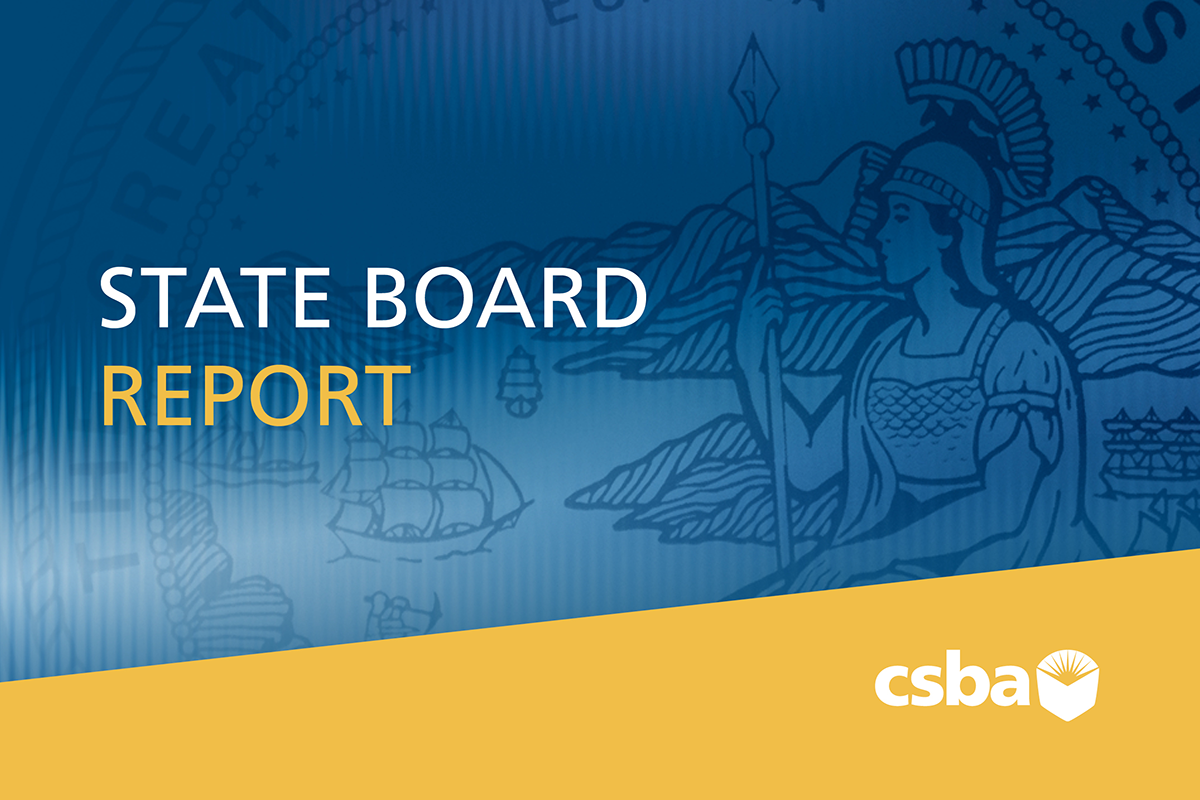In a packed one-day meeting on Jan. 12, the State Board of Education approved several revisions to the California Assessment of Student Performance and Progress and English Language Proficiency Assessments for California student score reports, as well as a California Community Schools Partnership Program Framework, California Physical Fitness Test flexibilities and more.
The meeting was also the last for long-time members Ting Sun, Patricia Rucker, Sue Burr and Vice President Ilene W. Straus. Their departure was met with heartfelt messages from former Gov. Jerry Brown, who had appointed all four, Board President Linda Darling-Hammond and others.
“I want to recognize that this set of board members has been the foundation — they’ve been instrumental in transforming education in the state of California. They helped to bring the school system back from the brink of collapse, develop the infrastructure for the Local Control Funding Formula and the Local Control and Accountability Plan,” Darling-Hammond said. “They redesigned the accountability system so it now focuses on broader measures of educational opportunity and attainment. What they have developed … has been the foundation on which we are building the next stage of California’s journey to demonstrate what a 21st-century education for all can be.”
Among the day’s main discussions were the implications of the 2020–21 assessment data — released Jan. 7 by the California Department of Education — which included student outcomes on the CAASPP; the California Science Test; and the California Alternate Assessments for English language arts, mathematics, and science as well as the California Spanish Assessment.
Just 25 percent of students took the 2020–21 state assessments, as most of the state’s urban districts remained in distance learning until late spring 2020 and did not administer the tests. However, the results of their locally administered tests that met specific criteria approved by the board generally show similar findings, according to a WestEd analysis.
CDE staff reported that the low participation rate makes it impossible to meaningfully measure growth or compare results during a year when most of California’s classrooms were closed to students. The department has released an interpretation guide for the available data.
The board approved revisions to the 2021–22 CAASPP and ELPAC student score reports to reflect the most recent updates to test administration and ensure that crucial information regarding student performance is communicated clearly to parents.
Among the key changes is the removal of school and state averages from each of the CAASPP score reports. Because state testing was suspended in 2019–20 and testing volumes were significantly lower than usual in 2020–21, these administration years do not provide a meaningful measure from which to compare 2021–22 statewide student performance, according to CDE staff.
In response to concern expressed during public comment surrounding the removal of statewide and district averages, board member Kim Pattillo Brownson noted that the change is not permanent, but necessary due to a lack of valid or reliable data.
“This is a ‘now’ situation because we want to remove things that could be confusing to parents because it’s just not available,” explained Mao Vang, director of the CDE’s Assessment Development and Administration Division.
Additionally, as claim results will not be available at the individual student level for the 2021–22 administration due to the SBE’s approval of the shortened tests in November 2021, approval was granted to update language on the score reports reflecting that. Cleanup revisions were also approved for several other state assessment documents.
In a separate action, the board approved the commencement of a 45-day public comment period for proposed amendments by the CDE to remove the listing of available accessibility resources, add language to address remote testing, and revise language throughout to align regulations with updated operational practices for the CAASPP and ELPAC systems.
Forging ahead on community schools
Taking the next step toward expanding the community school model statewide, the board approved the proposed California Community Schools Partnership Program (CCSPP) Framework, which details the key roles and responsibilities of local, county, regional and state partners; best practices; four cornerstone commitments and more.
While board members applauded the work that has taken place, Straus said more clarity is needed. The intent is there, she said, “but this is transformational … and I want to use $3 billion thoughtfully to make the impact that was intended for this program.”
Community schools are known for providing resources such as medical and dental care, as well as mental and behavioral health services, but the model hinges on a combination of academics with a wide range of vital in-house services, supports and opportunities that are integral to promoting children’s learning and overall development. Community schools prioritize strategic structures for integrating academics and collaborative leadership with youth and community development, health and social services, and community engagement in alignment with the goals and values of California’s Multi-Tiered System of Support to organize campuses around the academic, behavioral, social-emotional and mental health needs of students.
The CCSPP needs to be “a coherent, aligned program so that this is not another categorical layer that sits on top,” Straus said. “It doesn’t feel there yet.”
Rucker was one of several members who agreed and warned CDE staff against working in a vacuum while building coherence and guidance for implementation.
“The perspective of hearing from other folks who have done this work already and are deeply immersed in supporting and working with the schools will give some context to some of the elements you are considering and the guidance that you are offering,” Rucker said.
The 2021–22 Budget Act provides approximately $3 billion for the CCSPP to establish new, and expand existing, community schools. At its Nov. 3–4 meeting, the board approved the application process and administration plan for the CCSPP, established in 2020 with the first round of grants — $45 million in funding to existing community school initiatives — awarded in spring of 2021. Following the recommendation of CDE staff, the board approved at its Jan. 12 meeting several amendments to the administration plan related to the timeline and regional technical assistance centers’ request for applications and contract processes.
In other State Board meeting news:
- The board approved the executive summary of the State Annual Performance Report for Part B of the Individuals with Disabilities Education Act of 2004 covering program year 2020–21. This report provides data on the status of California’s students with disabilities in 17 indicators as required for submission annually under IDEA. During fiscal year 2020–21, about 2.6 million services were provided to the state’s students with disabilities, many of whom received multiple services through their local educational agency.
- The board approved a list of LEAs with approved Comprehensive Support and Improvement plan summaries. The State Board approves these final plans to meet ESSA standards, which “requires local educational agencies, in partnership with stakeholders, to develop and implement a comprehensive support and improvement (CSI) plan to improve student outcomes for each school identified for CSI.”
- The board approved a Finding of Emergency and Proposed Emergency Regulations and Amendments to provide LEAs with some flexibility related to the California Physical Fitness Test (PFT), typically administered in spring to students in grades five, seven and nine to assess six areas of fitness. The passage of Senate Bill 820 in 2020 requires the CDE to consult with partners with expertise in fitness, adapted physical education, gender identity, body image and students with disabilities in order to recommend improvements to the PFT and its administration. The State Superintendent of Public Instruction must submit a report with these recommendations to the appropriate fiscal and policy committees of the Legislature, the Department of Finance and the SBE by Nov. 1 of this year. However, LEAs would be required to administer the assessment as is this spring without consideration for recent concerns regarding the equitability and accessibility of the PFT. The approved regulations will provide LEAs flexibility in the administration of the tests “while collecting and reporting only participation results” as the panel’s work continues, according to CDE staff.
- The board considered recommendations from its screening committee and approved one appointment to the Advisory Commission on Special Education and two appointments to the Instructional Quality Commission.
- The board approved 2021–22 consolidated applications — the annual fiscal data collected from the LEAs as required under federal law. About $2.1 billion in federal funds are distributed annually through this process to support low-income, rural and immigrant youth, English learners and more.
The next State Board meeting is scheduled for March 9–10, 2022. View the full meeting calendar.




